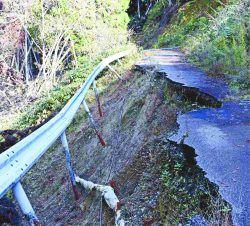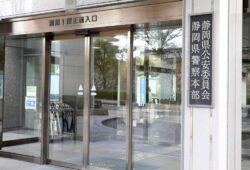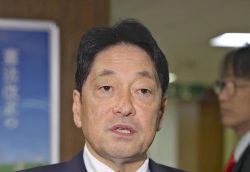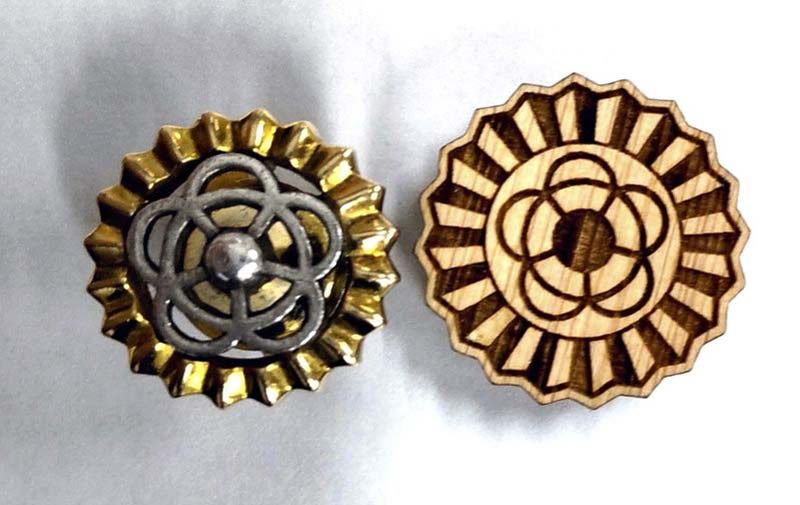
The existing Osaka prefectural assembly member’s pin, left, and a new wooden prefectural assembly member’s pin
December 1, 2021
OSAKA — The material for the Osaka prefectural assembly members’ pins is to be changed to wood, in principle, to cut costs, sources said. The pins currently in use at the 88-member assembly are gold-plated and cost ¥22,000 each, and local political party Osaka Ishin no Kai has proposed the change.
To alleviate concerns that the wooden pins could break, a cheaper gold-plated pin about one-sixth the price of the current version will also be made. These will lead to savings of at least ¥10,000 per assembly member, the sources said.
The current pin design has been used since 1931, according to the prefectural assembly secretariat. It is shaped like a gear to represent the prefecture’s flourishing textile industry. The prefectural flower, a plum blossom, appears in the center.
In recent years, however, more and more local assemblies have been reviewing the material used for member pins to cut costs and to respond to the rising price of gold.
In 2019, the Kyoto city assembly, which used to pay the highest unit price among the assemblies of all ordinance-designated cities at ¥61,600 for a pin with a gold body and platinum center, changed its composition to a gold-plated copper body and silver center, lowering the price to ¥9,000 per pin.
In March, the Osaka city assembly decided to reduce the cost of its member pins by 90% to about ¥6,000, changing the material from gold to gold-plated brass.
With these precedents, Osaka Ishin no Kai proposed in September changing the material of assembly member pins at the Osaka prefectural assembly.
The party proposed a wooden pin made of cypress produced in the prefecture for about ¥5,000. Other political groups argued, however, that a wooden pin could break or that it should be made of metal since it features an image of a gear. Finally, it was agreed to also make a gold-plated pin, priced at about ¥3,700, which is cheaper than the conventional member pin.
Pins used to be distributed to Osaka prefectural assembly members each time they were elected, but from now on, members will continue to use the same pin if they are reelected.
"Society" POPULAR ARTICLE
-

M4.9 Earthquake Hits Tokyo, Neighboring Prefectures
-

Israeli Tourists Refused Accommodation at Hotel in Japan’s Nagano Pref., Prompting Protest by Israeli Embassy and Probe by Prefecture
-

M7.5 Earthquake Hits Northern Japan; Tsunami Waves Observed in Hokkaido, Aomori and Iwate Prefectures
-

Tsukiji Market Urges Tourists to Avoid Visiting in Year-End
-
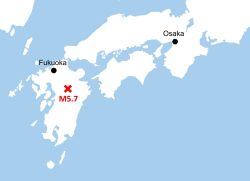
M5.7 Earthquake Hits Japan’s Kumamoto Pref., Measuring Upper 5 Intensity, No Tsunami Expected
JN ACCESS RANKING
-

Keidanren Chairman Yoshinobu Tsutsui Visits Kashiwazaki-Kariwa Nuclear Power Plant; Inspects New Emergency Safety System
-

Imports of Rare Earths from China Facing Delays, May Be Caused by Deterioration of Japan-China Relations
-

Tokyo Economic Security Forum to Hold Inaugural Meeting Amid Tense Global Environment
-

University of Tokyo Professor Discusses Japanese Economic Security in Interview Ahead of Forum
-

Japan Pulls out of Vietnam Nuclear Project, Complicating Hanoi’s Power Plans


